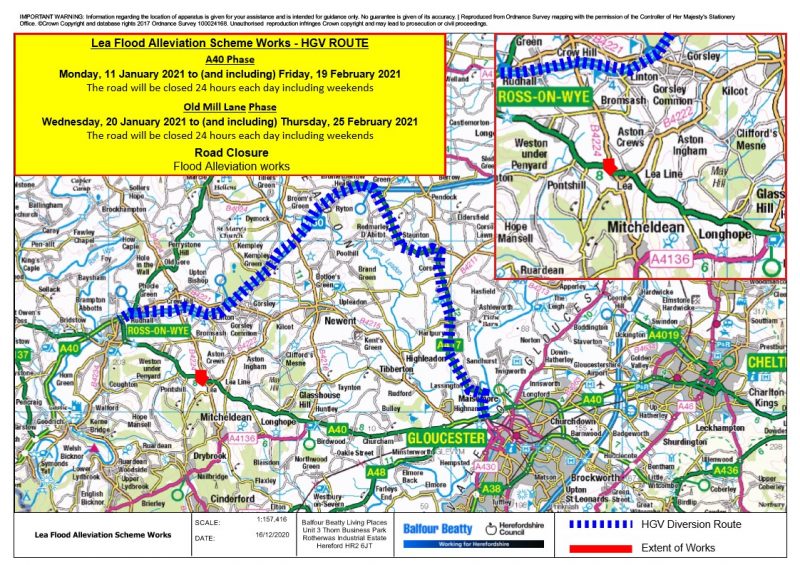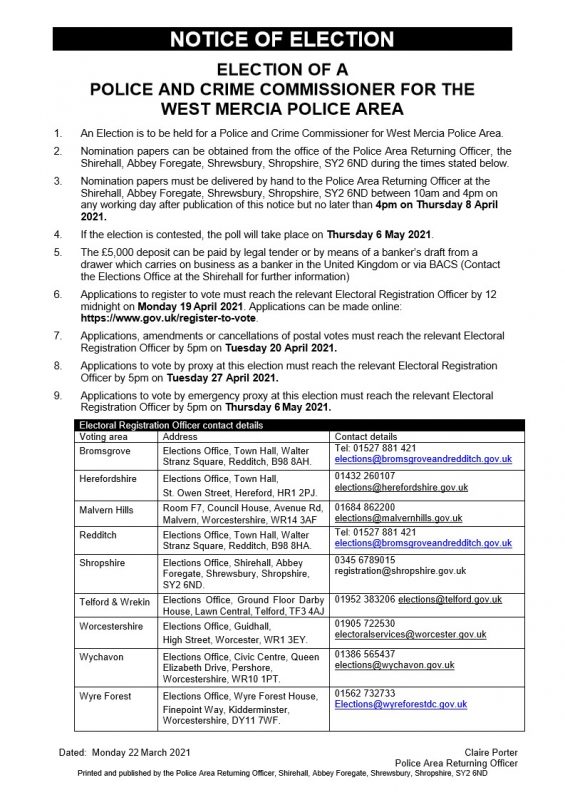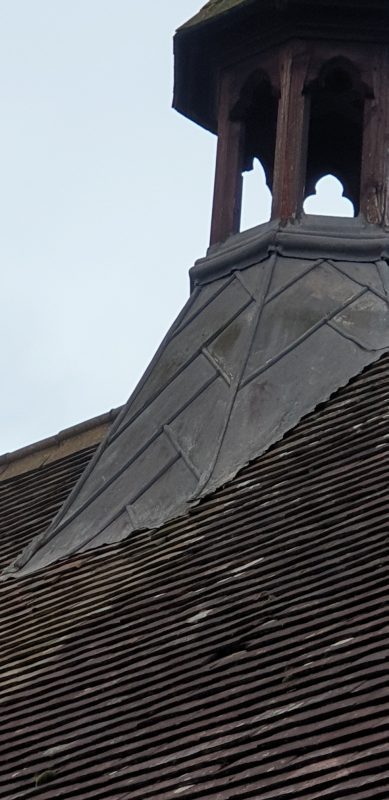Uncategorized
Take a Stand
Herefordshire businesses and organisations can now apply for up to four cycle parking stands, totally free of charge. A free installation service is included.
The scheme is provided by Herefordshire Council and managed by the cycling charity LifeCycle UK.
To apply for free stands, simply visit the LifeCycle UK website. https://www.lifecycleuk.org.uk/free-cycle-parking
Road ahead closed and diversion signs
ROAD CLOSURES – MARCH 2021 – 15.03.2021
HIGHWAY RESURFACING WORKS – ROAD CLOSURES
Resurfacing works (including white lining and stud works, if required) as well as any preparatory works (i.e. drainage, kerbing) if required.
C1095 – Ledgemoor – Change in end date
Tuesday, 2 March 2021 to (and including) Monday, 15 March 2021
Road closed 09.00 hours to 17.00 hours daily
C1083 – Bearwood Lane, Pembridge (Urban) – Change in end date
Tuesday, 9 March 2021 to (and including) Monday, 15 March 2021
Road closed 09.00 hours to 17.00 hours daily
C1219 – A465 to The Vroe, Rowlestone finish today
Tuesday, 9 March 2021 to (and including) Friday, 12 March 2021
Road closed 09.00 hours to 17.00 hours daily
No weekend working
C1091 – Venmore Lane, Dilwyn
Wednesday, 10 March 2021 to (and including) Thursday, 18 March 2021
Road closed 09.00 hours to 17.00 hours daily
No weekend working
U91424 – Manley Crescent, Pembridge – Change in end date
Thursday, 11 March to (and including) Monday, 15 March 2021
Road closed 09.00 hours to 17.00 hours daily
U73209 – Stoney Street, Madley
Friday, 12 March 2021 to (and including) Monday, 22 March 2021
Road closed 09.00 hours to 17.00 hours daily
No weekend working
C1059 – Common Farm Bungalow, Holloway Common Farm, Hampton Charles
Monday, 15 March 2021 to (and including) Monday, 22 March 2021
Road closed 09.00 hours to 17.00 hours daily
No weekend working
C1262 – Fawley Cross, How Caple
Monday, 15 March 2021 to (and including) Wednesday, 17 March 2021
Road closed 09.30 hours to 15.30 hours daily
U80011 – Union Street – Night Works
Wednesday, 17 March 2021 to (and including) Friday, 19 March 2021
Road closed 20.00 hours to 06.00 hours each night
U67412 – Terrace Farm, Woolhope – Postponed – new date to be advised in due course
U76208 – Church Street & U67220 Church Road, Ledbury
Friday, 19 March 2021 to (and including) Wednesday, 24 March 2021
Road closed 09.00 hours to 17.00 hours daily
No weekend working
C1127 – Hafod Road, Hereford
Friday, 19 March 2021 to (and including) Wednesday, 24 March 2021
Road closed 09.00 hours to 17.00 hours daily
No weekend working
A438 SCRIM Site Junction Falcon Lane, Nr Ledbury – Revised dates
Thursday, 25 March 2021 to (and including) Wednesday, 31 March 2021
Road closed 09.30 hours to 15.30 hours daily
No weekend working
C1110 – Pencombe – Revised dates
Thursday, 25 March 2021 (and including) Tuesday, 30 March 2021
Road closed 09.00 hours to 17.00 hours daily
No weekend working
U75016 – The Glibes, Michaelchurch Escley
Monday, 22 March 2021 and Tuesday, 23 March 2021
Road closed 09.00 hours to 17.00 hours daily
A417 – Hillhampton to Burley Gate
Wednesday, 24 March 2021 to (and including) Wednesday, 31 March 2021
Road closed 09.00 hours to 17.00 hours daily
No weekend working
U72632 – Auberrow Lane, Wellington
Wednesday, 24 March 2021 to (and including) Monday, 29 March 2021
Road closed 09.00 hours to 17.00 hours daily
No weekend working
A4103 – Newtown Crossroads – NIGHT WORKS
Wednesday, 24 March 2021 to (and including) Friday, 26 March 2021
Road closed 20.00 hours to 06.00 hours each evening
BRIDGE WORKS
C1075 Hobby Lyons Bridge, Eardisley Village (BB0199)
Road closed Monday, 8 March 2021 to (and including Wednesday, 17 March 2021
Full 24/7 closure: Road closed from 09.00 hours on Monday, 8 March and does not re-open until 17.00 hours on Wednesday, 17 March 2021
Parapet wall repair following RTC
C1219 Allt-yr-ynys Bridge, Walterstone
Road closed Wednesday, 17 March 2021 to (and including) Friday, 19 March 2021
Road closed 09.30 hours to 15.00 hours each day
Repairing surface dame to Bridge/voussoirs and repointing
C1185 – Bredwardine Bridge
Monday, 29 March 2021 to (and including) Wednesday, 31 March 2021
Road closed from 09.00 hours on Monday, 29 March and will not re-open until 17.00 hours on Wednesday, 31 March 2021
Waterproofing of surface of bridge and resurfacing works
DRAINAGE WORKS
Excavation of carriageway as part of improvements to the local drainage system:-
C1206/C1205 – Little Bridge Old Mill, Michaelchurch Escley – Works postponed, new dates to be advised in due course
C1086 – Waterloo Lane, Kinnersley to A438 (Letton)
Wednesday, 3 March 2021 to (and including) Friday, 19 March 2021
Full 24/7 closure: Road closed from 09.00 hours on 3 March 2021 and does not re-open until 17.00 hours on Friday, 19 March 2021
C1152 – From B4220 to Redcastle Farm, via Gold Hill (Bosbury)
Monday, 8 March 2021 to (and including) Friday, 19 March 2021
Full 24/7 closure: Road closed from 09.00 hours on 8 March 2021 and does not re-open until 17.00 hours on Friday, 19 March 2021
C1213 – Shepherds Hill to Great Walk Mill Farm, Dulas
Monday, 15 March 2021 to (and including) Thursday, 1 April 2021
Full 24/7 closure: Road closed from 09.00 hours on 16 March 2021 and does not re-open until 17.00 hours on 1 April 2021
C1055 – Kimbolton to Meadow Bank Park, Hamnish
Monday, 22 March 2021 to (and including) Friday, 26 March 2021
Full 24/7 closure: Road closed from 09.00 hours on 22 March 2021 and does not re-open until 17.00 hours on 26 March 2021
C1195 – B4348 to Woodfield Cottage, Stockley Hill, Peterchurch – New
Thursday, 25 March 2021 to (and including) Wednesday, 31 March 2021
Full 24/7 closure: Road closed from 09.00 hours on 25 March 2021 and does not re-open until 17.00 hours on 31 March 2021
FLOOD ALLEVIATION WORKS
A40/B4222 Lea Village Flood Alleviation Works
Road closed Monday, 11 January 2021 to (and including) Friday, 5 March 2021
Road closed 24 hours each day, 7 days a week
Please refer to the programme of works below:
A40 Phase
Works between Crown Barns and Old Mill Lane crossing the A40
Full Road closure between Monday, 11 January 2021 and Friday, 5 March 2021
The road will be closed 24 hours each day including weekends
Old Mill Lane Phase
The road will be closed 24 hours each day including weekends
Main Programme Dates:
Works along Old Mill Lane between Brook House and B4222
Main Deep Drainage run : road closed from Wednesday, 24 February to (and including) Friday, 5 March 2021.
Secondary Pipework (new gullies, connections and access chambers ) : road closed from Saturday, 6 March 2021 to (and including) Tuesday, 23 March 2021.
Resurfacing of Old Mill Lane : road closed from Tuesday, 23 March 2021 until (and including) Thursday, 25 March 2021.
B4222 – Mill Lane
Road closed Friday, Monday, 8 March 2021 to Wednesday, 10 March
Closed between 09.00 hours and 17.00 hours daily
OTHER ROAD CLOSURES
B4260 – Wilton Road and Wilton Bridge, Ross on Wye
Monday, 22 March 2021 to (and including) Friday, 26 March 2021
Wilton Bridge: Road closure Monday, 22 March 2021to (and including) Wednesday, 24 March 2021 – Road closed between Wilton Bridge and Wye Street junction. Wilton Road car park will be open (accessible from Wilton Road roundabout). The only access to Wye Street will be from Town Centre direction.
Road closed from 09.00 hours on 22 March 2021 and will not re-open until 17.00 hours on 24 March 2021.
Inspection of Bridge with underbridge unit.
Wilton Road and St Mary’s Street: Wednesday, 24 March 20201 to (and including) Friday, 26 March 2021 – Road closed from Wye Street junction to St Mary’s Street.
Road will be closed from 09.00 hours on 24 March 2021 and will not re-open until 17.00 hours on 26 March 2021
Investigation and inspection of rock face above Wilton Road. Removal of vegetation and loose debris.
Two footpaths will also be closed whilst these works take place:-
ZK20 – SO 5948 2391 to SO 5938 2386
ZK34 – SO 5953 2393 to SO 5946 2384
C1257 – Symonds Yat West Road (Ferrie Lane)
Road closed until further notice
B4224 – Fiddlers Green, Fownhope
Structural wall failure and landslip
Full road closure in place until Easter 2021
U71411 – Garway Court Lane
Carriageway deterioration
Full road closure in place until Wednesday, 31 March 2021
2021/2022 Grounds Maintenance Contracts
The 2021/22 Grounds Maintenance contracts are now available for prospective suppliers to tender for; closing date is 26th February 2021.
Theft of Lead from Field House
It is with disappointment that we report the Theft of Lead from the Roof of Field House in Credenhill. Formerly the School when the village was much smaller and now home to the Kindergarten who operate a nursery with very limited funds.
The theft occurred some time in the last week and as you can see from the photos a significant amount of Lead has been stolen.
The police have been informed and local scrap dealers will be made aware of the very distinctive pattern.
If you have any information then please get in touch.
LEA VILLAGE – FLOOD ALLEVIATION SCHEME – JANUARY/FEBRUARY 2021
A40/B4222 Lea Village Flood Alleviation Works
Road closed Monday, 11 January 2021 to (and including) Thursday, 25 February 2021
Road closed 24 hours each day, 7 days a week
Please refer to the programme of works below:
A40 Phase
Works between Crown Barns and Old Mill Lane crossing the A40
Full Road closure between Monday, 11 January 2021 and Friday, 19 February2021
The road will be closed 24 hours each day including weekends
Old Mill Lane Phase
The road will be closed 24 hours each day including weekends
Main Programme Dates:
Old Mill Lane adjacent to A40 ( Between Brook House and Derwent House )
Full Road closure between Wednesday, 20 January 2021 and Wednesday, 27 January 2021
Works along Old Mill Lane between Brook House and B4222:
Main Deep Drainage run : road closed from Wednesday, 27 January to (and including) Friday, 5 February 2021.
Secondary Pipework (new gullies, connections and access chambers ) : road closed from Saturday, 6 February 2021 to (and including) Monday, 22 February 2021.
Resurfacing of Old Mill Lane : road closed from Tuesday, 23 February 2021 until (and including) Thursday, 25 February 2021.


Poster of soldier with the words "We will remember
Remembrance Service 8th November 2020
MAGNIS GROUP
Credenhill, Brinsop & Wormsley, Mansel Lacy & Yazor, Kenchester, Bridge Sollars, Bishopstone.
REMEMBRANCE SUNDAY SERVICE
8th November 2020
at 10.45am
at
Credenhill War Memorial
We gather in silence
The priest says: God is our refuge and strength; a very present help in trouble. (Psalm 46:1)
“This I call to mind, and therefore I have hope: the steadfast love of the Lord never ceases, his mercies never come to an end; they are new every morning.” (Lamentations 3:21-23)
We are here to worship God, whose purposes are good; whose power sustains the world he has made; who loves us, though we have failed in his service; who gave Jesus Christ for the life of the world; who by his Holy Spirit leads us in his way. As we give thanks for his great works, we remember those who have lived and died in his service and in the service of others; we pray for all who suffer through war and are in need; we ask for his help and blessing that we may do his will, and that the whole world may acknowledge him, as Lord and King. At this time we remember Ypres, Gallipoli, the Somme, Mons and Verdun. We remember the Western Desert, El Alamein, the Normandy beaches. We remember Coventry, Dresden, Hiroshima and the Burma Road. We remember Korea, Malaya, the Falkland Islands, Northern Ireland, the Balkans, East Timor, Iraq, Afghanistan and the Gulf.
We remember the courage, the comradeship, the ingenuity, the spirit of working together for a common cause, the planning together, for a better world that would come with peace. We remember the carnage; the colossal horror of war. We remember the widows and people who never knew their fathers. We remember the love that was lost, the wisdom wasted, the minds that are still pained by memories.
We remember the families bereft by recent wars and conflict. We remember this day the children who will die while nation fights nation. Father, remember us; and forgive our sins against you and our fellow human beings. Amen.
HYMN
O God our help in ages past, our hope for years to come,
our shelter from the stormy blast, and our eternal home.
Under the shadow of thy throne, thy saints have dwelt secure;
sufficient is thine arm alone, and our defence is sure.
Before the hills in order stood, or earth received her frame,
from everlasting thou art God, to endless years the same.
A thousand ages in thy sight are like an evening gone;
short as the watch that ends the night before the rising sun.
Time like an ever rolling stream, will bear us all away;
we fade and vanish, as a dream dies at the op’ning day.
O God our help in ages past, our hope for years to come,
be thou our guard while troubles last, and our eternal home.
ACT OF REMEMBRANCE
A list is read of those remembered from 1914-1918 war and 1939-1945.
An older person says Binyon’s lines:
They shall grow not old as we that are left grow old:
age shall not weary them, nor the years condemn.
A younger person continues:
At the going down of the sun and in the morning,
we will remember them.
And all shall repeat: We will remember them.
The Last Post is sounded followed by
TWO MINUTES SILENCE.
Then the Reveille is sounded signifying that resurrection always follows death.
The Kohima Epitaph is said
When you go home, tell them of us and say
‘For your tomorrow – we gave our today’.
The following prayer is said
Ever-living God, we remember those whom you have gathered from the storm of war into the peace of your presence; may that same peace calm our fears, bring justice to all peoples and establish harmony among the nations, through Jesus Christ our Lord. Amen
THE LAYING OF WREATHS
Almighty and eternal God, from whose love in Christ we cannot be parted, either by death or life: hear our prayers and thanksgivings for all whom we remember this day; fulfil in them the purpose of Thy love; and bring us all, with them, to your eternal joy; through Jesus Christ our Lord. Amen.
THE BIBLE READING
Luke 12:1-7 – Meanwhile, when a crowd of many thousands had gathered, so that they were trampling on one another, Jesus began to speak first to his disciples, saying: “Be on your guard against the yeast of the Pharisees, which is hypocrisy. There is nothing concealed that will not be disclosed, or hidden that will not be made known. What you have said in the dark will be heard in the daylight, and what you have whispered in the ear in the inner rooms will be proclaimed from the roofs.
“I tell you, my friends, do not be afraid of those who kill the body and after that can do no more. But I will show you whom you should fear: Fear him who, after your body has been killed, has authority to throw you into hell. Yes, I tell you, fear him. Are not five sparrows sold for two pennies? Yet not one of them is forgotten by God. Indeed, the very hairs of your head are all numbered. Don’t be afraid; you are worth much more than many sparrows.
A SHORT ADDRESS
THE PRAYERS
All join together inTHE LORD’S PRAYER
Our Father, who art in heaven, hallowed be thy name.
Thy kingdom come, thy will be done;
on earth as it is in heaven.
Give us this day our daily bread,
And forgive us our trespasses,
as we forgive those who trespass against us.
And lead us not into temptation, but deliver us from evil.
For thine is the kingdom. the power, and the glory,
for ever and ever. Amen.
THE NATIONAL ANTHEM
God save our gracious Queen,
Long live our noble Queen,
God save the Queen.
Send her victorious,
Happy and glorious,
Long to reign over us:
God save the Queen.
Thy choicest gifts in store
On her be pleased to pour,
Long may she reign.
May she defend our laws,
And ever give us cause
To sing with heart and voice,
God save the Queen.
THE BLESSING
The priest says:
God grant to the living, grace; to the departed, rest;
to the Church, the Queen, the Commonwealth,
and all the people; unity, peace and concord.
And, to us and all God’s servants, life everlasting.
And the blessing of God Almighty,
Father, Son, and Holy Spirit,
be with you all,
and remain with you always. Amen.
Herefordshire Council Physical Activity Strategy Consultation
Herefordshire Council is developing a Physical Activity Strategy to develop a clear approach to physical activity within the county. This will be informed by local priorities and developed in partnership with key stakeholders. As part of this process, we would like to hear from local residents to understand their habits in relation to physical activity, exercise and sport. We would really appreciate it if you could fill in the survey found here: https://www.surveymonkey.co.uk/r/HerefordresPA
The survey is due to be open for six weeks starting today.
Partnership Information Bulletin 08/10/20
Please consider disseminating appropriately across your organisations and networks. You will also be able to find this information and more on our website https://herefordshiresafeguardingboards.org.uk/ |
| Two new guides to help reduce online sexual harm to children and young people Please see two new guides recently launched by the National Working Group – Online Sexual Harm Reduction Guide aimed at professionals; How Can I Help My Child? aimed at parents and carers. Given the current increase nationally in reported online abuse with children spending more time online and less time out in the community, alongside the speed of technology and the development of apps and trends online, parents, carers and professionals working with young people can find themselves confused and at a loss to know how to keep up. These documents can be used to supplement work with families and young people across Herefordshire. Latest Newsletter from No Wrong Door Project The No Wrong Door Project from hvoss (Herefordshire Voluntary Organisations Support Service) have published their latest weekly newsletter World Mental Health Day resources Mentally Healthy Schools have created a toolkit of resources for World Mental Health Day on 10 October that focus on inclusivity and celebrating our differences. The resources in this toolkit are designed to help schools support pupils who may need more help with their mental health and celebrate the unique and different qualities that each child brings to a school community. Resolution of Professional Differences Policy Please see the link to our latest Resolution of Professional Differences Policy on the West Midlands Regional Child Protection Procedures website. For the latest UK Government information on Coronavirus (Covid-19) https://www.gov.uk/coronavirus |
TRAVEL NOTICE
A480 Road Closure
Service 71/71A Hereford – Credenhill
Due to the closure of the A480 at Credenhill from Monday 5 October until Friday 9 October 2020 between 0930 and 1530, bus services will be affected as follows: Credenhill village will be served by a shuttle bus service operating between Dovecote Lane and Stretton Sugwas only. The shuttle service will connect with services 71/71A at Stretton Sugwas where passengers will transfer for journeys to or from Hereford city centre.
Buses will run normally on Mondays to Fridays outside of the closure times and all day Saturdays and Sundays.
Service 461/462 Hereford – Weobley – Kington
Due to the closure of the A480 at Credenhill from Monday 5 October until Friday 9 October 2020 between 0930 and 1530, and the Mondays to Fridays closure of the A480 at Brinsop Junction from Friday 9 October until Monday 19 October 2020 between 0900 and 1700 bus services will NOT operate via the normal route but will run to Weobley then via the A438 Eardisley road into Hereford. This stop will therefore not be served between these times by service 461/462.
Buses will run normally on Mondays to Fridays outside of the closure times and all day Saturdays.



